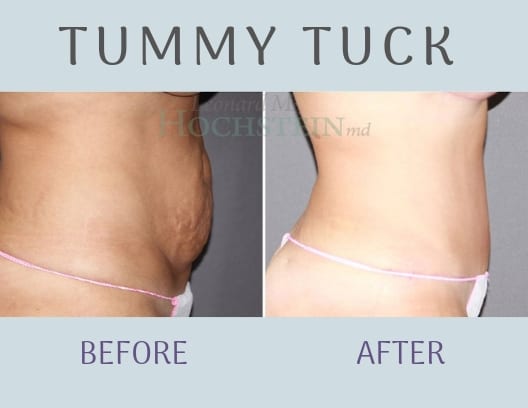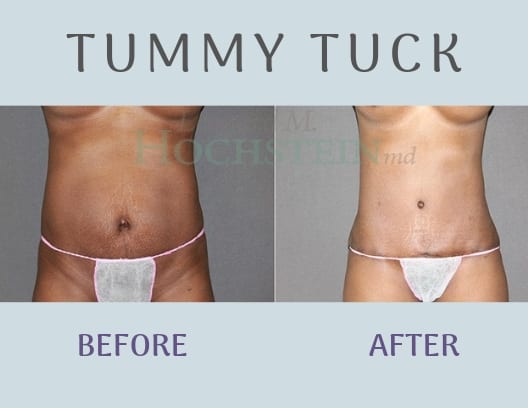For many of us, having a midsection that puffs out or protrudes can be a source of embarrassment. A flabby tummy affects the contours of our bodies and can make us look larger and even older than we really are. Many of us strive to achieve that smooth, flat tummy through exercise, diet, and by leading a generally healthy lifestyle.
But sometimes, these measures may not be enough to remove excess skin or stubborn fatty areas around the midsection. Factors such as age, heredity, childbirth, and weight loss can all contribute to a “paunch” in the mid- and lower abdomen that is difficult to remove. A tummy tuck can help address these concerns and get you the flat tummy you’ve always wanted.
 What Is a Tummy Tuck?
What Is a Tummy Tuck?
Also referred to as an abdominoplasty, a tummy tuck is a procedure that removes excess fat and skin to tighten and reduce the abdominal area. A tummy tuck can reduce fat in the abdomen, tighten skin and muscles, and even remove stretch marks. This will lead to an overall smoother and flatter profile that falls more in line with the rest of your natural body contour.
Tummy tuck surgery is ideal for candidates who:
- Have concerns about the appearance of their midsection
- Have excess skin and fat that have not responded to other methods
- Have weak abdominal muscles from childbirth or other injuries
- Are in good physical health
- Have reached their ideal weight and been able to maintain it
How Is a Tummy Tuck Done?
A tummy tuck will typically incorporate a series of incisions—usually around the navel and between the belly button and pubic area—to remove the excess fat and tighten muscles. Dr. Hochstein may also use some form of liposuction to siphon some of the excess fat before redraping and tightening muscles and removing extra skin. The incisions are then closed together using sutures, stitches, or other adhesive methods.
Dr. Hochstein offers three options that each offer a different level of correction to the abdomen: a mini, full, and extended tummy tuck.
A mini tummy tuck focuses mostly on the lower abdominal area and can be ideal for women who have developed a stubborn pouch in the lower belly after pregnancy; a full tummy tuck focuses on the entire abdomen; an extended tummy tuck for patients with more severe symptoms.
Dr. Hochstein will also address weaknesses in the abdominal wall during a full and extended tummy tuck and tighten any muscles as needed. Excess skin and stretch marks will also be addressed in both procedures and removed as much as possible.
Tummy Tuck Consultation
If you are interested in undergoing a tummy tuck, you will first start with a consultation. Dr. Hochstein will discuss the procedure and work with you to come up with goals and listen to what you expect out of the procedure. You will be asked about your prior medical history, previous surgeries or procedures, and any current medications or supplements.
During the consultation, Dr. Hochstein will closely examine your midsection to pinpoint areas of concern and come up with a plan that will ensure the best likely outcome. This is a good time to ask as many questions as you’d like about the procedure, how it’s done, and what to expect during your recovery. Any risks that may arise from a tummy tuck will also be discussed.
Tummy Tuck Preparation
In the weeks before your tummy tuck surgery, you may need to undergo lab testing or a medical evaluation to ensure there are no complications. Certain medications or supplements may need to be stopped or adjusted, and any smoking needs to be stopped as well. Anti-inflammatory medications, such as aspirin and herbal supplements, should be avoided as they can increase bleeding during and after the procedure.
A tummy tuck can be performed as an outpatient procedure, but you will need some time to rest and recover. There will be some soreness after the surgery, especially in the first few hours and days. For most patients, it’s suggested to take at least two weeks off work and other routine activities for a quicker, easier recovery. It is important and required to have arrangements to be driven home and to have someone stay with you for 24 hours after the procedure is completed.
Tummy Tuck Recovery
After your tummy tuck is completed, Dr. Hochstein will provide a compression garment that goes around your midsection area that will help minimize pain and swelling. There will also be bandages and dressings applied to the incision areas. One or two Jackson Pratt drains will be inserted close to the hip area near your tummy tuck incision to remove fluids that build up after your surgery.
Dr. Hochstein will provide a pain pump in the days right after the surgery and prescribe oral medication to manage pain as you recover. He also offers lymphatic drainage, a type of therapeutic massage that helps reduce inflammation. These massages help get rid of excess liquid that often accumulates after surgery.
Full recovery after a tummy tuck will typically take about six to eight weeks. During this time, physical activity should be minimized or avoided. Dr. Hochstein will provide specific post-operative directions that should be followed after surgery for a quick recovery.
Are you ready for a tummy tuck? Find out more and schedule a consultation by calling our offices at 305-931-3338.
